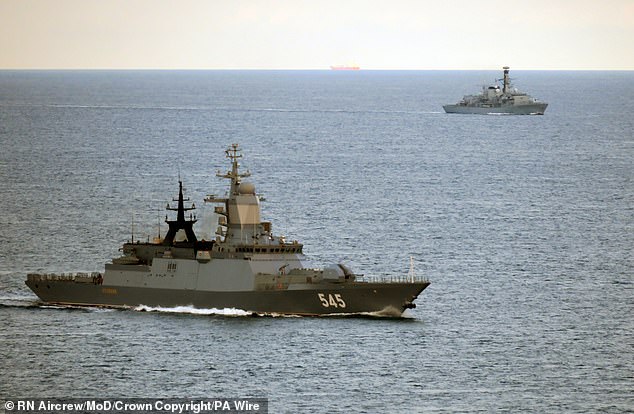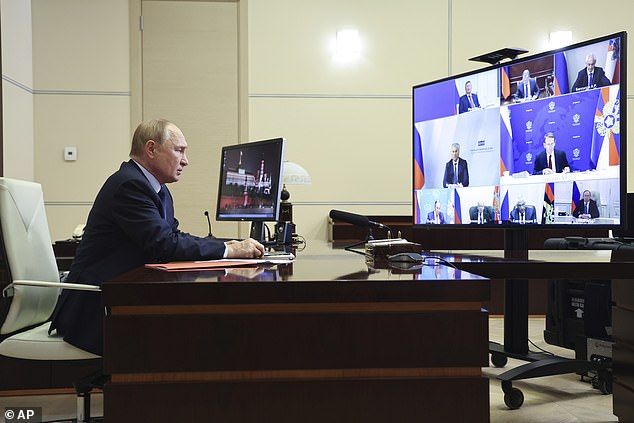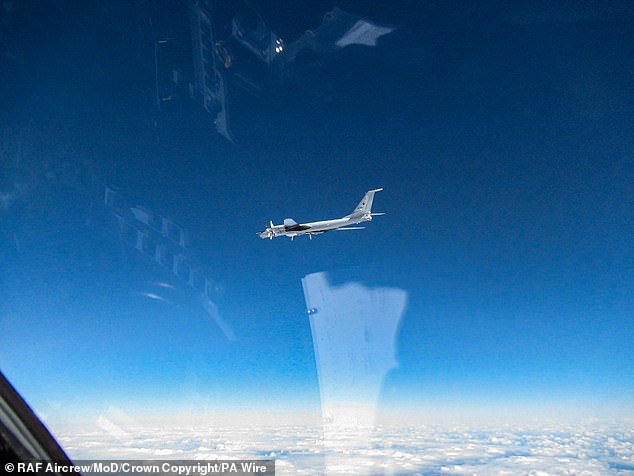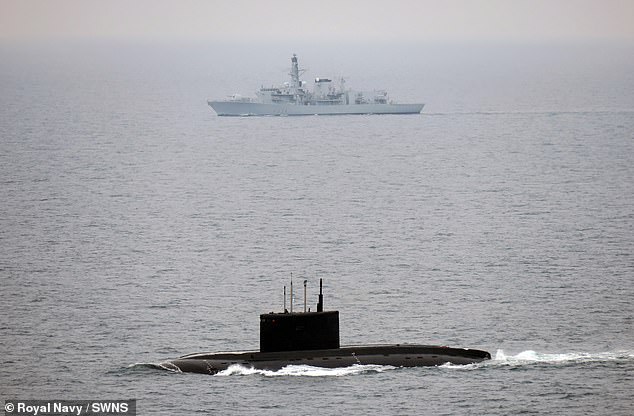Royal Navy warship tracks Putin submarine in Channel as four Russian ships enter British waters and RAF fighter jets intercept bomber amid rising tensions over Ukraine and threats to ‘sink’ Britain
The Royal Navy and RAF tracked several Russian ships and submarines through the English Channel last week amid rising tensions.
HMS Iron Duke and HMS Tyne have tracked four Russian ships in British waters in recent days, while RAF fighter jets intercepted a Russian strategic bomber on Wednesday.
The Navy’s warships followed the Russian advance to “protect national security,” while four ships sailed through the Channel and the North Sea.
On Wednesday two RAF Typhoons also took off from RAF Lossiemouth, supported by a Voyager from RAF Brize Norton, to intercept Russian Bear-F aircraft.
The developments come as tensions between Russia and Britain have risen over Moscow’s ongoing war in Ukraine and Britain’s support for Kiev. This week, a top Kremlin spokesman and a former president threatened to “sink” Britain.
HMS Iron Duke followed the Kilo-class submarine Novorossiysk and the supporting tug Evgeny Churov through the Strait of Dover and into the Atlantic Ocean

HMS Iron Duke (right rear) follows the Russian Navy Steregushchiy-class corvette RFS Stoiky

Russian President Vladimir Putin chairs a meeting with members of the Security Council via video conference at the Novo-Ogaryovo State Residence, outside Moscow, Russia, Friday, September 13, 2024.

Interception of a Tu-95 Bear F on September 11, 2024 captured by the pilot’s handheld camera
“The island of Great Britain will probably sink within a few years,” Dmitry Medvedev wrote on his personal social media account, adding: “Our hypersonic missiles will help if necessary.”
Medvedev’s threats against Britain follow a series of statements by Putin’s propagandists demanding nuclear strikes to drown the UK in tsunamis caused by his hypersonic missiles or the super-fast Poseidon underwater drone.
And Putin himself has warned that Britain and other Western countries that support Ukraine will face the harshest consequences if they allow Ukraine to fire NATO-supplied long-range missiles at military targets deep inside Russia.
Defence Secretary John Healey said the “efforts of the Royal Navy and RAF over the past two weeks demonstrate their selfless commitment to protecting our national security.
“This government wants to make the UK safe at home and strong abroad,” he added in a statement.
“I would like to thank the members of our armed forces who participated in this operation. Their professionalism and skills were fully demonstrated in their seamless cooperation with our NATO allies to uphold international standards.”
The Navy worked with its NATO allies to choreograph the shadowing of the Kilo-class submarine Novorossiysk and supporting tug Evgeny Churov through the Strait of Dover into the Atlantic Ocean.
The careful operation began in early September, when the Canadian warship HMCS Shawinigan escorted the diesel submarine and her support ship as they sailed from the Baltic to the North Sea.
The Canadian patrol ship handed over control duties to the Royal Navy as the Russian ships approached the busy Strait of Dover.
From there, HMS Iron Duke kept a constant eye on the two ships, using her many sensors, including her Wildcat helicopter from the 815th Naval Air Squadron in the air.
The submarine remained on the surface throughout the operation.
After the Russian ships passed into British waters, HMS Iron Duke handed over shadow duties to the Marine Nationale off the north-west coast of France, where the frigate FS Auvergne took over the mission.
The ship then immediately returned to the North Sea for an almost exact replica of the operation – this time with the Steregushchiy-class corvette Stoiky and the tanker MT Yaz as she approached Dover. She was shadowed by the Belgian Navy, whose patrol ship BNS Castor had been on watch until then.
The RAF was also called in to track a Tupolev Tu-95 strategic bomber flying near the UK.

Royal Navy warships have been closely monitoring the Russian navy over the past week as four of its vessels sailed through the Channel and the North Sea, helping to protect national security.
The Royal Navy said: ‘The RAF fighter jets were launched under NATO command and worked closely with our partners to monitor the aircraft as they flew through international airspace.
‘Our Typhoon fighters escorted the aircraft out of the UK flight information region and at no time did the Russian aircraft enter UK airspace.’
Typhoons are part of the RAF’s Quick Reaction Alert, which puts aircraft in Scotland and England on high alert 365 days a year to defend and protect UK airspace.
During both voyages past the UK, the Russian warships and their support vessels were closely monitored by British forces to ensure they operated in a safe and non-threatening manner.
The journeys are permitted under international law, in accordance with the right of innocent passage.
“These were the fourth and fifth operations of this type for HMS Iron Duke since we emerged from a period of intensive training in July,” said HMS Iron Duke’s Commander David Armstrong.
‘I am extremely proud of the professionalism and selfless dedication that the shipping company consistently demonstrates in carrying out their duties.
‘Maritime security operations of this nature are a fundamental capability of the Royal Navy, with the protection of our sovereign waters and vital national infrastructure a key focus.’
Meanwhile, Russia is conducting war exercises with artillery fire in the Barents Sea, part of the largest naval exercise since the Cold War.
New exercises include firing Vulkan and Onyx cruise missiles by Northern Fleet troops against a simulated Western adversary in the Arctic Sea, off the northern coasts of Norway and Russia.
The exercises involved the missile cruiser Marshal Ustinov and the Tu-142 anti-submarine aircraft. Separately, Tu-22M3 bombers attacked an ‘enemy’ ship group.
The artillery bombardments on a naval target were carried out by the ship attack group of the Russian Northern Fleet, which also included the frigates Admiral Kasatonov and Admiral Golovko.
Naval exercises also took place in the Caspian Sea.
